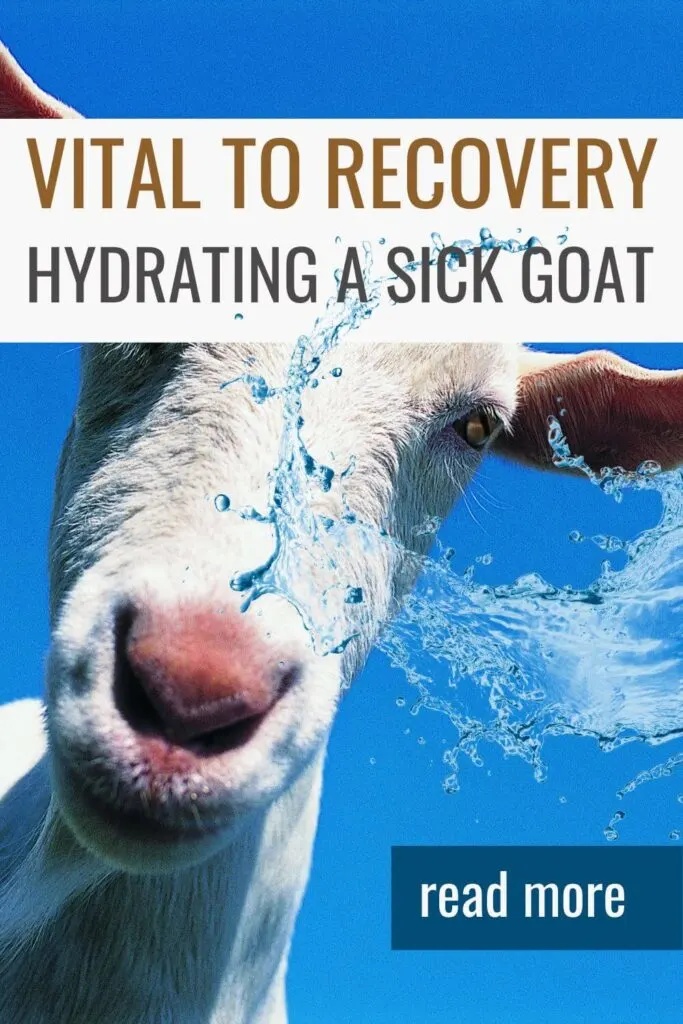Ensuring Vital Recovery: The Critical Role of Hydration and Nutrition for Sick Goats
A sick goat requires meticulous care to facilitate a swift and thorough recovery. Two fundamental aspects stand out in this care regimen: hydration and nutrition. In this article, we will explore the crucial role of providing enough liquids and sustenance for a sick goat, outlining the necessary steps and resources for goat owners to ensure their caprine companions receive the care they need during illness.
The treatment to the illness your goat is experiencing is important but just as important is keeping them hydrated and fed as they recover.
You can get the recipe for electrolytes in My Goat Binder along with other treatment plans. You’ll also be able to write down everything you give your goat so you don’t forget what treatments were given, when and the outcome. As a goat owner, you need to become the best record keeper you can be.
The Significance of Hydration in Goat Recovery
1. Fluid Balance:
- Goats, like all animals, depend on proper fluid balance for physiological functions.
- Sick goats may experience dehydration due to reduced water intake or fluid loss from illness.
2. Electrolyte Importance:
- Illness can disrupt the electrolyte balance in goats, exacerbating dehydration.
- Electrolytes are vital for nerve function, muscle contraction, and maintaining overall health.
3. How Much Liquid is Enough?
- A 100 pound sick goat will need 1 gallon of fluids per day.
- Administer small amounts frequently to encourage intake. But doing this syringe by syringe all day long will be stressful for both you and the goat. If the goat is not drinking willingly or on its own, you will need to stomach tube the goat to get the proper amount of fluids and nutrition. Although this might be new to you, it is something you can learn and it will end up being less stressful for the goat.
- To put this into perspective so that you know how hard it would be for you to syringe a 100 pound goat enough fluids: they will need 3840 cc’s of fluid a day for it to equal the 128 fluid ounces that make up a gallon.
4. Signs of Dehydration:
- Sunken eyes, dry mouth, lethargy, and reduced skin elasticity indicate dehydration.
- Prompt intervention is crucial to prevent further complications.
Nutritional Support: Feeding a Sick Goat
1. Maintaining Caloric Intake:
- Sick goats often lose their appetite, risking nutritional deficiencies.
- Offering palatable, nutrient-dense foods is essential for recovery.
2. Critical Nutrients:
- Focus on providing easily digestible feeds rich in energy, protein, and essential minerals.
- Alfalfa hay, grain concentrates, and specialized goat feeds are suitable options.
- If the goat is not eating, and hasn’t eaten for 2-3 days, it’s essential that you take matters into your own hands and give them what they need. You can give something like Entrolyte, which has 13% protein it and tube it into the goat’s stomach directly. Entrolyte (not Entrolyte HE) is an oral calf ruminant powder. If this isn’t available, give something that is equivalent to it.
3. Frequent, Small Meals:
- Divide daily feedings into several small meals to encourage eating.
- Monitor consumption to ensure the goat is meeting nutritional needs.
Essential Resources for Goat Owners
1. Electrolyte Solutions:
- Keep commercial electrolyte solutions on hand. Or use the recipe in My Goat Binder to make your own.
- Electrolyte solutions are readily available at veterinary supply stores and are crucial for rehydration. Or the ingredients to make your own are easily available and easy to make!
2. Oral Syringes/Stomach Tubes:
- Have oral syringes available for administering liquids if the goat refuses to drink.
- This ensures precise delivery and minimizes stress.
- Have an adult and kid sized stomach tube on hand just in case you do need to go this route.
- Also have a weak kid syringe on hand.
3. High-Quality Hay and Feed:
- Stock up on high-quality hay and goat-specific feeds.
- These provide essential nutrients to support recovery.
4. Isolation Space:
- Isolate sick goats to prevent the spread of illness within the herd.
- Create a quiet, stress-free environment conducive to recovery.
5. Thermometer:
- Keep a rectal thermometer to monitor the goat’s temperature. Always have a working thermometer on hand and always take the goat’s temperature anytime you think they are sick.
- Elevated temperatures may indicate infection or inflammation.
- Low temperatures indicate that the body is shutting down.
6. Regular Monitoring:
- Monitor the sick goat’s behavior, appetite, and vital signs.
- Regular assessments help gauge the effectiveness of treatment.
Conclusion: A Holistic Approach to Recovery
Ensuring a sick goat receives adequate liquids and nutrition is paramount for a successful recovery. Goat owners play a pivotal role in providing the necessary resources and care. By addressing hydration and nutritional needs promptly, owners contribute to the overall well-being of their goats during times of illness. Remember, consulting with a veterinarian for specific guidance tailored to the individual goat’s condition is always advisable for optimal care.
If you want to learn even more about your goats, start here: Raising Goats Resource Page
